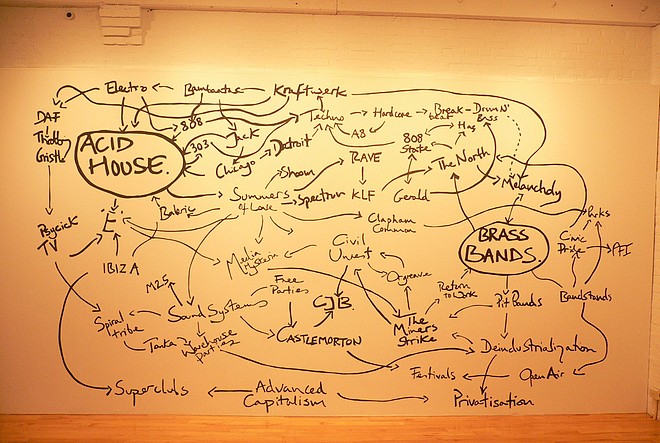Acid Brass: A short History - Jeremy Deller
It’s nice to know that some pub ideas can actually make it out that cost environment and be made flesh. Acid Brass was conceived in such a place a few years ago on a hot summer’s night at a point in the evening when the conversation started to slip and slide.
The idea was a simple one; to get a traditional brass band to play a selection of Acid House anthems.
As soon as the words had been said I thought that this could have a life beyond the pub as it immediately conjured up a series of conflicting images and ideas. The flow diagram below is basically how my brain worked in these few seconds; and stands as both the musical and social justification for the project. It’s personal interpretation but I’d like to think that we all have similar maps somewhere in our heads.

‘A History of the World’ – the original installation, Jeremy Deller 1997
I had initially thought that it would be a problem finding a band that would be willing to take the risk of performing these songs in public but I was wrong. The brass band world is always looking for new material to perform as an attempt to find a younger audience. This combined with the forward looking attitude of their manager John Cresswell meant that there were few problems in persuading the band to commit itself to the project. Having said that, the first time I met John and saw the band perform I deemphasised the Acid House aspect and called the tracks ‘contemporary electronic dance music’. It was over the following months that I introduced the A word, and as it was no one batted an eye-lid. The original Acid Brass album was recorded live in Liverpool at the first public appearance of the material. It was an exciting evening for a number of reasons the most obvious being neither myself, the band or the audience knew quite what was going to happen over the next hour. This was especially the case for the band as they had had only one rehearsal of the piece due to their busy performance schedule. In fact a few of the musicians were sight reading that night. The fact that the concert and the recording went so well is testament to their ability to rise to the occasion.
Since then they have become better acquainted with the music and more importantly how to approach it stylistically. The songs I chose were and still are favourites of mine, they were also tracks that I thought would translate happily for a brass band. Indeed the brass band sound is that of menace, melancholy, and is inevitably uplifting just like the memorable Acid House recordings.
I’ve used the ‘Acid House’ definition in the broadest possible sense which has allowed me to include tracks such as the pre-acid classic ‘This Brutal House’ and the epic techno that is ‘Cubik’. Although this is a studio album the ten tracks were recorded in one take with no overdubs and so retain the ambience of a live performance. The session was completed in a little over six hours.
I’d like to thank, John Cresswell the Band Manager, Bryan Biggs from the Bluecoat Arts Centre, David Sefton from the South Bank Centre and Paul Smith from Blast First Records for their confidence in what was initially just two words put together on a drunken summers evening.
– Jeremy Deller
Jeremy’s First Contact with the Band
My first contact with the Fairey Band was through telephone conversations with John Cresswell. I’d been given his number by Brass Band World but I have to admit that I was nervous about approaching him with the idea for “Acid Brass”. I had expected the Brass Band community to be totally dismissive of the project and I couldn’t believe it when he happily agreed to the idea. Admittedly I didn’t mention the words “Acid House”, I called it “a new commission for Brass Bands involving contemporary dance music”. What I also didn’t tell him was that not one note had been transposed and the budget was around £2,000 short. Minor details as far as I was concerned, I’d managed somehow to get myself the best Brass Band in the country through a single phone call.
The first face to face meeting was at Kenwood Bowl on a wet Bank Holiday weekend. It was also the first time that I had met Rodney Newton, sheltering under an umbrella. His enthusiasm was such a lift and everything that night was falling into place. This was especially the case when the Band struck up: I was blown away by their playing, and I’m not ashamed to say that it brought a tear to my eye. seeing and hearing them reminded me why I had wanted to do this in the first instance.
I later found John and he took me backstage to see the Band. I didn’t really meet anyone at this point, I just stood in a corner with my cup of tea and digestive trying to be invisible. I have to admit that the first few times I was around the Band, I was petrified by them as I felt such an outsider, it seemed to be such a tight knit group of friends like a football team or army brigade even. Also I thought they might resent playing the songs – what if I caused a mutiny in the Band? The next time I saw the Band was in Birmingham, it was there I became aware of what the Brass Band movement is up against. The Band was playing beautifully to a respectably sized audience, but in the front row there was an elderly woman doing her knitting, hardly rock and roll! It was at this point that I began to realise why John was so up for taking a risk with me and “Acid Brass”.
Listen to Jeremy Deller discussing the concept of Acid Brass on the BBC’s Culture Show
